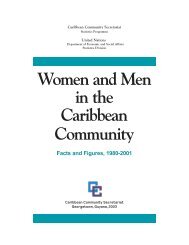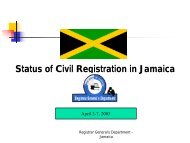CARICOM CAPACITY DEVELOPMENT PROGRAMME (CCDP)
CARICOM CAPACITY DEVELOPMENT PROGRAMME (CCDP)
CARICOM CAPACITY DEVELOPMENT PROGRAMME (CCDP)
Create successful ePaper yourself
Turn your PDF publications into a flip-book with our unique Google optimized e-Paper software.
National Census Report 2001, St. Vincent and the Grenadinesforce participation rate increased by a percentage point during the intercensal period, while therate among males decreased by 6.1 percentage points during that same period.The population 65 and over and 15 to 19 years as well as those 60-64 years experienced thelowest labour force participation rate compared to those in the other age groups. Labour forceparticipation rate was lowest among those 65 years and over with a rate of 14.81 followed bythose 15-19 age group with a rate of 34.26 while those 60-64 age group had a participation rateof 37.58 and those 55-59 had a rate of 55.16. This is generally expected since most of thepopulation in the 15 to 19 age group are usually still in the school, while most of the 65 yearsand over are retired or engaged in home duties. The corresponding rate among the other agegroups ranged from 69.28 for the 50 to 54 to 77.28 for the 35 to 39 age groups.In the 15 to 19 age group, the participation rate among the males was more than twice that for thefemales, 46.39 and 22.01 respectively, (Table 5.2). The wide gap between males and females inthis age group signifies the earlier entrance of males into the labour force, which could be due tothe failure of the males to complete a secondary or higher level of education. The data on schoolattendance indicate that a higher percentage of females (55.14 per cent) compared to males(42.94 per cent) in this age group attended school. Evidently females in this age group arestaying in school longer than the males and delaying their entrance into the labour force.Overall, this age group has experienced a decrease in labour force participation compared to1991, which signifies a general delay in the entrance to the labour force.The sex gap in labour force participation was also wide in the population 55 years and over. Itis likely that most of the females in this age group had never participated in the labour force andwere mainly engaged in home duties during their productive years. Furthermore, femalesgenerally retire at an earlier age than males.5.4 Employed Labour ForceThere were 35 036 employed 17 persons in the labour force in 2001 (Table 5.1). This representsan increase of 1 529 employed persons compared to 1991. This overall increase is the net result17 Persons who during the reference period worked or had a job but were not at work61










